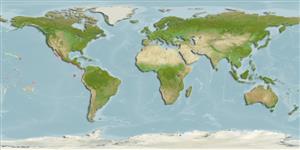Environment: milieu / climate zone / depth range / distribution range
Écologie
marin récifal; non migrateur; profondeur 4 - 30 m (Ref. 5227). Tropical; 28°N -
Eastern Pacific: Gulf of California to Peru, including the Galapagos Islands.
Taille / Poids / Âge
Maturity: Lm ? range ? - ? cm
Max length : 35.6 cm TL mâle / non sexé; (Ref. 5592); common length : 15.0 cm TL mâle / non sexé; (Ref. 55763)
Diurnal grazer on sessile invertebrates and algae but specializes to a larger extent on sponges. Also feeds on plankton. Reproduction occurs in late summer. Females are more territorial and form pair bonds with the males. Oviparous (Ref. 240), monogamous (Ref. 52884). Sometimes forms mixed aggregations with Pomacanthus zonipectus (Ref. 9333). Cleaning behavior has been observed in juveniles.
Life cycle and mating behavior
Maturities | Reproduction | Spawnings | Egg(s) | Fecundities | Larves
Spawn daily throughout the lunar cycle (Ref. 240). Protogyny has been proposed for this species awaiting confirmation (Ref. 103751). Monogamous mating is observed as both facultative and social (Ref. 52884).
Thomson, D.A., 1987. Reef fishes of the Sea of Cortez. The rocky-shore fishes of the Gulf of California. The University of Arizona Press, Tucson. 302 p. (Ref. 5592)
Statut dans la liste rouge de l'IUCN (Ref. 130435)
Menace pour l'homme
Harmless
Utilisations par l'homme
Pêcheries: commercial; Aquarium: Commercial
Outils
Articles particuliers
Télécharger en XML
Sources Internet
Estimates based on models
Preferred temperature (Ref.
123201): 22.9 - 29.1, mean 27 °C (based on 211 cells).
Phylogenetic diversity index (Ref.
82804): PD
50 = 0.5078 [Uniqueness, from 0.5 = low to 2.0 = high].
Bayesian length-weight: a=0.02951 (0.01513 - 0.05755), b=2.91 (2.74 - 3.08), in cm total length, based on LWR estimates for this species & (Sub)family-body (Ref.
93245).
Niveau trophique (Ref.
69278): 2.6 ±0.33 se; based on food items.
Generation time: 8.7 ( na - na) years. Estimated as median ln(3)/K based on 1
growth studies.
Résilience (Ref.
120179): Faible, temps minimum de doublement de population : 4,5 à 14 années (Preliminary K or Fecundity.).
Fishing Vulnerability (Ref.
59153): Moderate to high vulnerability (54 of 100).
Nutrients (Ref.
124155): Calcium = 44.8 [22.2, 76.4] mg/100g; Iron = 0.524 [0.313, 0.874] mg/100g; Protein = 18.2 [16.9, 19.4] %; Omega3 = 0.0876 [, ] g/100g; Selenium = 30.6 [16.1, 58.5] μg/100g; VitaminA = 65 [15, 248] μg/100g; Zinc = 1.4 [1.0, 2.0] mg/100g (wet weight);
